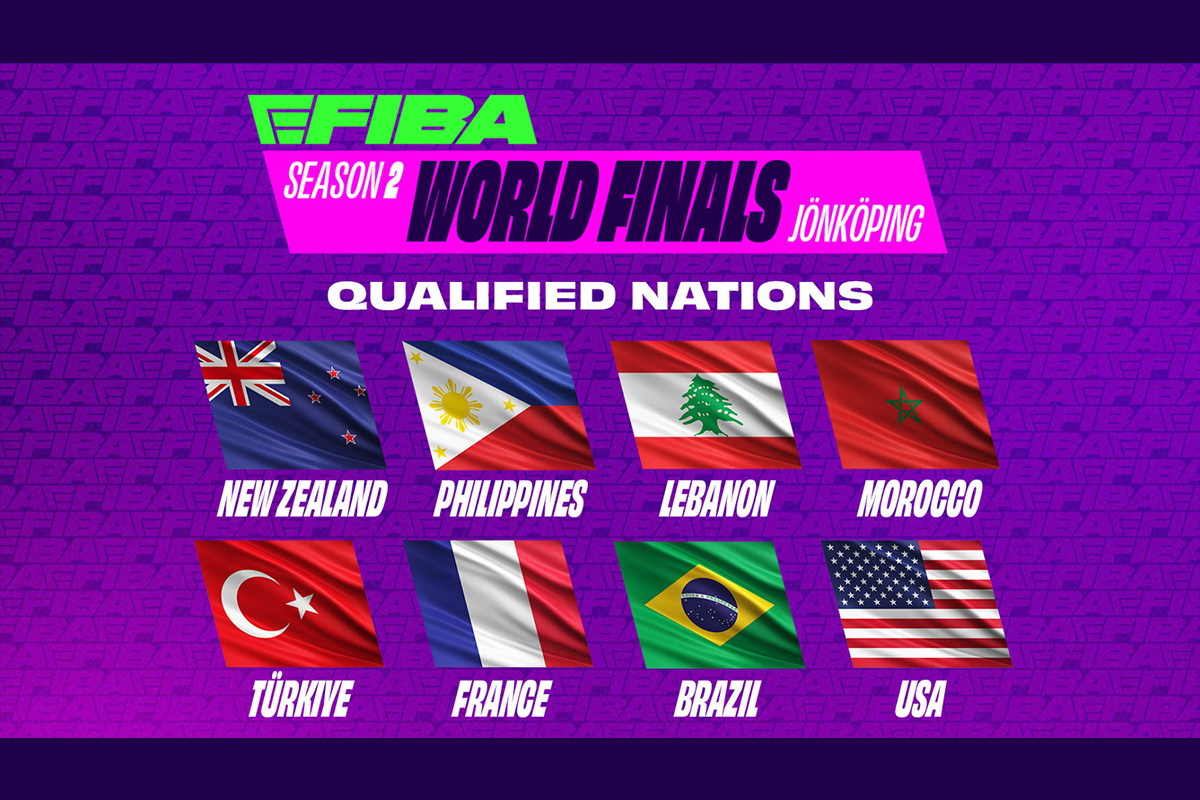

Latest News
eFIBA Season 2: Everything you need to know ahead of eFIBA’s First-Ever Live World Finals!
Copenhagen, November 10th, 2023 – The first ever in-person eFIBA Finals will take place this November 25-26 at DreamHack Winter in Jönköping, Sweden. The top eight nations will compete for the title of eFIBA World Champions, as well as the lion’s share of the €50,000 prize pool, with competing nations from Africa, Asia, Europe, Middle East, North America, South America, and Oceania.
Here is all you need to know about the eFIBA S2 World Finals
Commencing November 25, the top eight nations will go head-to-head on stage at the immersive gaming lifestyle festival, DreamHack Winter. This will mark the first time in history that national teams from around the globe compete for the ultimate international title in competitive NBA 2K24. The winner will receive the ultimate bragging rights as the first-ever eFIBA World Champion, the largest portion of the €50,000 prize pool, and a live trophy ceremony on stage at DreamHack Winter.
Competition schedule and format
After six intense weeks of online qualifiers, eight nations secured their spot in the eFIBA Season 2 World Finals. Nations from Africa, Asia, Europe, Middle East, North America, South America, and Oceania will be at DreamHack Winter to have a chance at being crowned the eFIBA World Champions. All games in the World Finals will be played in the best-of-three format.
Day One – November 25th
- Eight nations will be divided into two groups of four.
- Nations will play against each other once to decide the final group standings.
- The Group Stages will begin at 12:15pm CET.
- The top two nations from each group will progress to the semi-finals.
Day Two – November 26th
- The winners of each group will face off against the runners-up of the other group in best-of-three semi-finals.
- The semi-finals will begin at 10:45am CET.
- The third and fourth-placed nations from each group will face off in a series of classification games, which will begin at 12:00pm CET.
- The losers of the semi-finals will compete against one another in the Bronze playoff at 3:00pm CET.
- The semi-final winners will progress to the Final, where the eventual winner will be crowned World Champions, which begins at 3:30pm CET.
Nations Attending and Regional Champions
- Lebanon – eFIBA Season 2 Middle East Champions
- Morocco – eFIBA Season 2 Africa Champions
- New Zealand – eFIBA Season 2 Oceania Champions
- Philippines – eFIBA Season 2 Asia Champions
- Türkiye – eFIBA Season 2 Europe Champions
- France – eFIBA Season 2 Europe Champions
- USA – eFIBA Season 2 North America Champions
- Brazil – eFIBA Season 2 South America Champions
Broadcast Talent:
Seasoned Desk Host Vince Change will be leading the broadcast, with Chris Sampson, the Expert, offering in-depth game knowwedge. Zunaid Suleman and Nate Patrick will be the Sideline Reporters across all matches.
Prize Money
| TOTAL | €50,000 |
| 1st | €20,000 |
| 2nd | €10,000 |
| 3rd | €6,000 |
| 4th | €4,000 |
| Skillboosters | €5,000 |
| MVP | €2,500 |
| Defensive Player of the Year | €2,500 |
A grand total of €50,000 is up for grabs in the prize pool. €40,000 is designated as prize money for the top four nations, with another €10,000 to be awarded to individual players. €5,000 will be awarded based on skill-boosters acquired by nations in the semi-finals and final. The Most Valuable Player (MVP) and the Defensive Player of the Year will take home another €2,500 each from their magnificent performances.
Where to Watch
Fans tuning in online and watching the games from around the world can look forward to an exciting broadcast filled with extra content. The live broadcast will be available on the eFIBA Twitch, YouTube and TikTok channels, on FIBA’s Twitch and YouTube channels as well as via national streamers from around the world.
Those looking to experience the action live can look to purchase a DreamHack Winter festival ticket, as these also grant access to the eFIBA stage. More information, including available ticket types and prices, is available here.
For more details about eFIBA and the latest updates, visit the official channels on X (formerly Twitter), Instagram, and the official website. For more general information, visit eslfaceitgroup.com or follow ESL FACEIT Group on LinkedIn.
eSports
Esports Charts and GG.BET have presented an interactive map with data on tournaments around the world

Esports Charts, an analytical service that analyzes esports viewership, has partnered up with betting brand GG.BET, to present Esports Map, an interactive map with data on the most popular esports tournaments in 110 different countries. Each tournament also comes with historical moments when favorites and outsiders unexpectedly switched places in the bracket.
The analytical service Esports Charts has added a new interactive tool to its website, the Esports Map. It features the most popular tournaments by country, as well as data on peak viewership, winners, and prize pools. It also contains information on the most popular games in each country. There are also separate analytics dedicated to the United States, with information available for each of the 50 states. Data has been collected for a period spanning from 2017 up to right now, and is continuously updated.
GG.BET, who partnered with the project, supplemented the tournament information with interesting facts about participating teams. The insights include historical breakthroughs by underdogs and unexpected losses by tournament favorites. The information is provided using past outright betting data.
Esports Map allows users to track the esports industry’s development in various parts of the world. For instance, although League of Legends remains the most popular game and the League of Legends World Championship has kept its spot as the top esports tournament for many years, Mobile Legends: Bang Bang (MLBB) is visibly closing the gap between the two games. Worlds 2024 in London had 6,856,769 peak viewers, breaking the world record among all esports games since 2017. However, MPL Indonesia’s Season 15 of MLBB has kept its place in the top spot for 2025, with 4,132,224 peak viewers. Today, MLBB remains the only mobile game capable of attracting such a massive audience, and its fan base is growing, especially in Southeast Asia. Analysts are looking forward to Worlds 2025 in China, which will allow them to update the available data and compare how different games are developing.
“Esports Map is a new project from Esports Charts, which we’ve launched alongside GG.BET as our first partner. We aimed to create a tool that would be interesting and useful to both fans and industry professionals. At its core lies Esports Charts’ analytics, supplemented by betting insights from GG.BET—covering everything from peak viewership and prize pools to discipline trends and stories of unexpected victories.. When combined, this data turns into a live snapshot of esports that can be tracked by country and region,” said Esports Charts’ press office.
“GG.BET regularly supports projects that help people understand esports at a greater depth. Esports Map provides an easy-to-understand visual representation of the industry’s progress in individual countries around the world and displays the breakdown of games by region. It will be of interest to fans and will prove useful to professionals who are developing the industry,” added GG.BET’s press office.
Esports Charts and GG.BET have previously worked together on an analytical project dedicated to the BLAST Premier 2024 season. That project displayed data on views, unique statistics about both the game and bets placed, an analytical breakdown of the season, and exclusive infographics on teams and players.
The post Esports Charts and GG.BET have presented an interactive map with data on tournaments around the world appeared first on Gaming and Gambling Industry in the Americas.
casinos online chile
Eventioz.cl Announces Launch of New Comprehensive Online Casino Resource in Chile

Eventioz.cl is thrilled to announce the launch of its new comprehensive online casino resource in Chile. With an experienced team dedicated to utilizing thorough, transparent analysis and reviews, Eventioz.cl’s goal is to provide useful resources for Chilean players, whether they are just starting out or already experienced in casinos online chile.
“We warmly welcome you to the site that brings together the most renowned and safe casino experts in Chile,” said a spokesperson for Eventioz.cl. “Every veteran of the booking world knows the wide variety of online casinos in Chile. In our opinion, an online casino must meet several key features so that we can consider it a great online casino in Chile: our goal is to help you find sites that have them.”
Online casinos in Chile are experiencing rapid growth in popularity, offering players a diverse range of games, enticing promotions, and secure payment options. With so many platforms available, players need clear and trustworthy information that explains which casinos are reliable, which games are worth trying, and how to play responsibly.
Eventioz.cl helps players to find the best online casinos in Chile by focusing on safe and reliable platforms that offer the most popular games, including roulette, slots, blackjack, poker, bingo, and live dealer experiences. The new resource also features platforms that enable players to deposit and withdraw safely using local and digital options, such as Cuenta RUT, Mach, WebPay, RedCompra, bancoestado, and cryptocurrency.
From highlighting how to confidently choose a safe and reliable online casino in Chile by encouraging players to search for key signs of trustworthiness, including licensing, payment security, and reputation, to the best bonuses and promotions for Chilean players, such as welcome offers, free spins, loyalty programs, and other special deals, Eventioz.cl aims to showcase the casinos with the top user-experience.
Along with reviews, best online casino lists, and helpful guides, Eventioz.cl offers easy navigation to community forums, shared player experiences, and practical tips for managing play and finding support if needed, all with mobile compatibility and Spanish-language support.
With more Chileans choosing online casinos over land-based ones due to convenience, accessibility, and the gamification of online casinos with more achievements, tournaments, and interactive features that feel like video games, Eventioz.cl takes into account diverse player preferences, cultural habits, and new trends shaping the online gambling scene to offer an all-inclusive location to online casinos in Chile.
Eventioz.cl invites players seeking the best casino online chile to browse its new resource today to find the ideal platform to suit their unique needs, preferences and budget.
The post Eventioz.cl Announces Launch of New Comprehensive Online Casino Resource in Chile appeared first on Gaming and Gambling Industry in the Americas.
affiliate marketing
How to Choose an iGaming Offer: N1 Partners x RichAds Share Their Expertise

What does it really take to pick the right iGaming offer for promotion? With so many variables to consider, it’s easy to make mistakes, especially for affiliates just starting out.
To help clarify things, N1 Partners and the RichAds ad network joined forces to share practical advice on choosing profitable offers and avoiding common pitfalls.
The conversation took place during the N1 Puzzle Promo — a competition where affiliates, both seasoned and new, experiment with different traffic sources, tools, brands, and GEOs to achieve one main goal: maximize profits from their traffic. And selecting the right offer is the first step toward success.
Meet the Experts
Before diving into the tips, here are the people sharing their insights:

Daria Maichuk Affiliate Manager at N1 Partners |
 Veronika Ponomareva Head of Customer Service at RichAds |
What is RichAds?
RichAds is an ad network offering a wide range of traffic sources, including:
- Telegram ads
- Push notifications
- Popunders
- Domain redirects
- Native ads
- Display traffic
Prices start at just $0.005 CPC for push ads and $0.5 CPM for popunders, with access to traffic across 200+ GEOs from Tier 3 to Tier 1.
How to Choose an iGaming Offer: Expert Advice
We asked Daria and Veronika the most important questions affiliates have when evaluating iGaming offers.
1. What parameters of an iGaming offer should be analyzed first before launching?
Daria Maichuk
“Start with the GEO: is gambling legal, how competitive is the market, and how solvent is the audience? Then check the payment model (CPA, RevShare, Hybrid) and the funnel: registration flow, minimum deposit, and site usability. The product matters too — top providers, live casino, sports, esports, localization, and bonuses. Finally, look at retention: how long players stay active and what campaigns keep them engaged.”
Veronika Ponomareva
“First of all, it’s the payout conditions, brand and its reputation on the market, as well as the funnel flow and the content of pre-landing/landing pages to pay attention to. Many things can affect a campaign’s result such as verification before the first deposit, the lack of locally popular payment methods support and the first deposit amount.”
2. How can a beginner determine the potential of an offer? Which metrics should they focus on to avoid wasting budget?
Daria Maichuk
“Key metrics are Conversion Rate (CR), Earnings Per Click (EPC), and Click-Through Rate (CTR). A low CTR usually means the offer doesn’t match the audience or creatives. Test multiple landers — welcome pages and reg forms typically perform best. Also consider First Time Deposits (FTD) and retention, as they reflect the long-term potential of an offer.”
Veronika Ponomareva
“Cost per registration, cost per conversion and ROI — are basic yet the most crucial things to look at. Potential means the long-lasting profit, so pay attention to the LTV (Lifetime Value). An offer could have a moderate EPC, but if the player retention is high and brings many secondary deposits, then the LTV would be extremely high accordingly. Ask your manager about the LTV of the offer in the required geo.”
3. How does a brand’s license affect the choice of GEO and traffic?
Daria Maichuk
“White licenses allow affiliates to work in regulated markets and run campaigns on official ad channels like Google Ads, FB, and TikTok. Grey licenses are also usable, but platforms often restrict or ban them, so affiliates need strong moderation skills.”
Veronika Ponomareva
“The licensing topic is highly important due to the fact that it determines the legality of traffic and what sources are acessible. Strict licenses (MGA, UKGC) approve only the cleanest traffic (mostly PPC and SEO). The traffic is very expensive, but provides quality leads. Curacao license gives more freedom as you can work with push-traffic, teasers and popunders. High risks come with no license at all as well as the accessible traffic sources are very limited.”
4. Which three GEOs currently deliver the highest ROI in iGaming, and why?
Daria Maichuk
“Germany: high purchasing power, stable LTV and retention, large deposits, strong conversion.
Canada: fast-growing, high trust in licensed brands, boosting CR and retention.
Australia: players spend more, stay active longer, and convert well into deposits.”
Veronika Ponomareva
“Depends on the traffic source we’re looking at, for example, if it’s either push or pop, then Bangladesh, Brazil and South Africa are currently on top.”
5. How can you understand whether an offer fits your main traffic source (FB, PPC, push, etc.) before testing?
Daria Maichuk
“Beginners often test blindly, but it’s possible to know in advance. FB and Google are the most widespread sources. Google traffic is highly engaged because players search for the product themselves. Facebook is harder for retention, but we work actively to improve it, especially for this audience, where push campaigns are essential. Push/Pop works for most offers, though CR is lower. If an offer has working apps (ASO), it can also be promoted through stores.”
Veronika Ponomareva
“Facebook and Google Ads are following strict guidelines on accessible content regarding iGaming offers, so it’s a common headache for marketers to test offers there and co-exist with moderation rules. Push and pop traffic doesn’t apply so many demands to the advertising content, so they’re way more preferrable for promotion means. So are Telegram Mini Apps, by the way, since they feature more tolerant moderation by advertising networks and fresh relevant audience.”
6. Top 3 traffic sources for iGaming in 2025?
Daria Maichuk
“Google: high-intent users, precise targeting.
Facebook: huge reach, flexible creative testing.
SEO: long-term stability, independent of traffic costs, especially effective for RevShare.”
Veronika Ponomareva
“Telegram Mini Apps: fresh audience, broad opportunities for advertising formats and extremely relevant users who come from casual games and tap-to-earn clickers.
Push-notifications: proven traffic source with high CTR and pre-made user bases that provide easier outreach to converting players.
Popunders: high CR and cost-effective means for promotion, since quality landing pages are usually enough to convert impulsive gamblers.”
7. Do your affiliates drive traffic through Telegram and what are the specifics? What do you think about mini-app traffic?
Daria Maichuk
“Yes, we’ve seen such cases, but most affiliates still prefer other sources. Data is still limited, but we’re closely monitoring Telegram and mini-app traffic and see strong potential here.”
Veronika Ponomareva
“For us it’s a channel that we actively explore, since introducing Telegram Mini App ads showed us how much of a potential they hold straight away. First of all, TMAs themselves offer a global coverage and outreach to a variety of potential leads for the iGaming products, coming from all over games and applications. In fact, since the moderation policies there are independent from the official Telegram Ads platform, that gives additional interest to this traffic.”
8. How many FTDs are needed to objectively evaluate an iGaming offer?
Daria Maichuk
“PPC: 20–30 FTD.
Facebook (slots): 20–30 FTD.
Facebook (crash games): at least 100 FTD.
In-app: around 100 FTD.”
Veronika Ponomareva
“At least 30 FtD, but to evaluate the offer properly it’s best to look into the player activity in the long run, the average amount of the deposits and other in-depth metrics.”
9. Which KPIs do you recommend for testing: ROI, FTD, deposit, or retention?
Daria Maichuk
“We often use soft KPIs. On average, we expect the avg dep count to be >=2. Sometimes we also track the ratio of total deposits to partner payout.”
Veronika Ponomareva
“It’s a complex matter as hitting the KPIs is usually the result of a combination of factors getting along.”
10. What should affiliates do if an offer “drops” after two weeks — switch or optimize?
Daria Maichuk
“If results were good initially, optimize creatives and targeting. If not, check whether the creatives included slots actually available in the product. Our managers always provide updated slot and targeting recommendations.”
Veronika Ponomareva
“Optimize the campaign, examine the metrics, check the creatives, change landing pages – try to find the correlation to this in the traffic performance.”
11. Which statistical indicators show that an offer can be scaled?
Daria Maichuk
“The main sign is stable positive ROI over several days or weeks. Also look at the funnel (click → registration → deposit) and player retention.”
Veronika Ponomareva
“Simply, a more or less stable ROI is the main indicator here.”
12. How to scale an offer within one source without lowering CR?
Daria Maichuk
“Increase budgets gradually — 10–20% every 1–2 days. Scale your best-performing bundles first. Always refresh creatives: without new content, audiences burn out and CR declines.”
Veronika Ponomareva
“The same level scaling is the key. If by creatives, then create new combinations of creatives and landing pages. If by the audience — gradually add more newcomer oriented targetings, instead of increasing the bids on the current ones. Just test everything by degrees.”
Conclusion
The N1 Puzzle Promo highlighted not only the competitive spirit among affiliates but also the importance of knowing how to pick the right iGaming offers. From choosing GEOs and traffic sources to tracking KPIs and scaling campaigns, the advice from N1 Partners and RichAds gives affiliates a clear roadmap to better results.
RichAds continues to support the iGaming community with its self-serve platform, offering access to 220+ GEOs and multiple traffic types from push and popunders to Telegram Mini Apps and native ads.
Launch smarter campaigns, work with the right offers, and grow your iGaming profits!
The post How to Choose an iGaming Offer: N1 Partners x RichAds Share Their Expertise appeared first on Gaming and Gambling Industry in the Americas.
-

 gaming3 years ago
gaming3 years agoODIN by 4Players: Immersive, state-of-the-art in-game audio launches into the next generation of gaming
-
EEG iGaming Directory9 years ago
iSoftBet continues to grow with new release Forest Mania
-
News8 years ago
Softbroke collaborates with Asia Live Tech for the expansion of the service line in the igaming market
-
News7 years ago
Super Bowl LIII: NFL Fans Can Bet on the #1 Sportsbook Review Site Betting-Super-Bowl.com, Providing Free Unbiased and Trusted News, Picks and Predictions
-
iGaming Industry8 years ago
Rick Meitzler appointed to the Indian Gaming Magazine Advisory Board for 2018
-
News7 years ago
REVEALED: Top eSports players set to earn $3.2 million in 2019
-
iGaming Industry8 years ago
French Senator raises Loot Boxes to France’s Gambling Regulator
-
News7 years ago
Exclusive Interview with Miklos Handa (Founder of the email marketing solutions, “MailMike.net”), speaker at Vienna International Gaming Expo 2018













